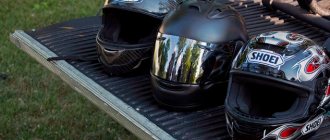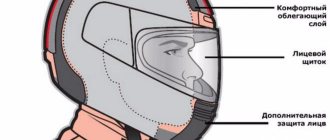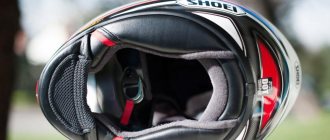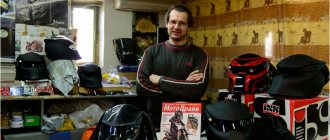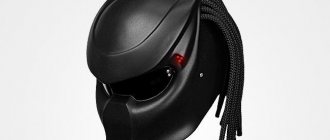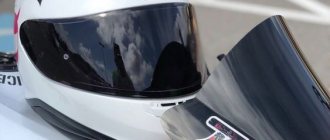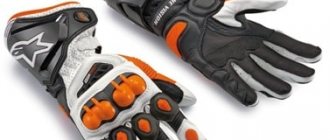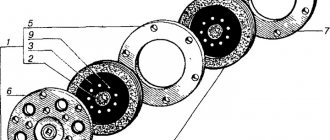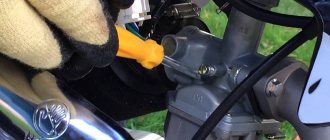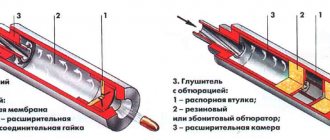Choosing a motorcycle helmet. Sizing and Type Selection Guide
Choosing a motorcycle helmet is not only about choosing the size and color. You choose something that will be between your head and a hard surface in the event of an accident. And how well a motorcycle helmet will protect you depends on how well it fits. All safety tests, all certificates and approvals are valid only if the helmet fits well and tightly on the head.
In the event of a collision, the helmet padding must absorb the impact energy. But if there is too much clearance between the helmet and your head, you will literally allow the helmet to hit you. Some helmets have built-in movable protective elements that distribute rotational loads from the helmet. If such an element does not fit well to the head, it does not work as it should.
On the other hand, if the helmet is too tight, it will be uncomfortable. He will disappoint, he will hurt, and you will simply give up on him. The correct choice of motorcycle helmet prevents both problems and allows the helmet to perform as intended, providing comfort while riding and protection in case of trouble.
All helmets are different. And that doesn't mean that simply having a tighter wallet is enough to get good protection and a comfortable fit. There are plenty of options on sale to suit every budget, head shape and size, and riding style. When choosing, you need not so much money as attention and patience.
Difficult? Don't worry. With our helmet selection guide, this task will not be so difficult. If you know how to use a measuring tape, can shake your head and ask a friend for help, you can handle choosing a helmet that fits perfectly!
Ready? Here are 6 steps on the way to getting exactly your helmet:
- Choosing the type of motorcycle helmet
- Determining the size and shape of the head
- Trying on a helmet
- Checking the fit
- We wear a helmet for half an hour
- Let's go for a ride
Choosing the type of motorcycle helmet
Motorcyclists have never had such a wide selection of helmets available to them. This is encouraging and discouraging at the same time. Where to begin?
There are five main types of helmets.
Open motorcycle helmet
Open motorcycle helmet
The first is an open-face motorcycle helmet. This type has no face-protecting features, except for clear visors on some of them. We include in this category both half helmets (shells, braincaps) and 3/4 helmets with back protection. What they have in common is that they have excellent airflow to the face and do not cover the chin. Helmets of this type are usually cheaper than others, and they are not particularly rich in comfort features. Typically, this type of helmet is worn by owners of cruisers, retro bikes and classics.
Integral
Integral
The Integral is a motorcycle helmet that is in many ways the opposite of an open-face helmet. It is designed in such a way that, in addition to the skull, it protects the nose, forehead, eyes and chin. The integrals have minimal airflow, but provide maximum protection to the face from collisions. They also have the maximum level of noise insulation. The Integral is the only option for the race track and the most popular type of helmet for riding any road bike.
Modular
Modular
Modulars can be considered a type of integrals, but they are often contrasted with each other rather than combined. These helmets have a hinge that allows the chin-protecting part of the helmet - also called the jaw or visor - to be raised, turning the helmet into something like a 3/4 helmet. Thanks to their modular design, modulars got their name. It's essentially two in one: you can choose to have near-maximum integral level protection, or open the visor and enjoy the freedom inherent in 3/4 helmets. This is very convenient during stops; you don’t have to take off your motorcycle helmet while resting, drinking, or eating. However, please note: the vast majority of modulars are not designed for riding with an open visor (and those that are are classified as transformable helmets, but there are few such models and we will not talk about them separately). The disadvantages of modulars are increased weight (the mobility of the visor is ensured by a hinge, often metal), a lower level of noise insulation, and a slightly reduced degree of jaw protection compared to a “full-body” integral. However, modulars are becoming better every year: more reliable, stronger, lighter, and no wonder: they are extremely popular among tourists and urban motorcyclists, for whom a motorcycle is an everyday vehicle, and comfort is very important to them.
Helmet adventure
Helmet adventure
For those who periodically drive off the asphalt, there is a category of adventure helmets. These helmets combine features important for both on-road and off-road riding. For driving on asphalt, such motorcycle helmets have road safety certificates and a visor, and when driving on dirt, they work like off-road helmets: a visor, ventilation and the ability to wear glasses. Of course, their dual nature leads to a number of limitations and compromises, but for those whose trips consist of on-road and off-road, there are probably no more convenient options. Adventure helmets are usually worn by owners of dual-purpose and touring motorcycles.
Off-road motorcycle helmet
Off-road motorcycle helmet
And finally, an off-road motorcycle helmet. They are also called cross, enduro, mud, and for fans of the corresponding disciplines there is a big difference between the different options. But for the vast majority, these helmets are about the same. What they have in common is that they are almost never certified for road safety, and in countries that do, off-road helmets are probably not safe to ride on the road. These helmets have excellent ventilation and a large visor to protect the eyes from splashes and branches. (Although off-road helmets do not have the usual on-road safety ratings, there are special safety ratings for off-road helmets, specifically from the Snell Foundation.)
In professional reviews, the visor is often called a visor, but such helmets do not have a transparent visor. They are designed for riding in special goggles (also called goggles), reminiscent of ski goggles. And these glasses are almost always sold separately from helmets. These helmets are extremely lightweight but ooze comfort. These helmets are designed for off-road riding and should not be chosen for driving on asphalt.
Shell
The shell, that is, the outer part of the helmet, can be made of various materials. We distinguish between two main categories of shells: polymer and composite. The first includes all types of plastics - from really bad to pretty good. However, composite helmets should be lighter and at the same time have a more durable shell. As you can guess, they will also be more expensive. Composites have another advantage - they do not lose their properties over time. The situation is different with polymers, which after a few years cease to fully fulfill their role.
You can see this by picking up some plastic, such as an old ruler - if you bend it, small cracks will start to appear; they are not as flexible as they used to be. Five years is supposed to be the time after which a plastic helmet should be replaced with a new one. There is no point in worrying about the names of individual composites—manufacturers often have names and patents. It’s better to choose a helmet with ventilation, aerodynamics and other aspects that are all right, than to choose according to the principle “this composite should be stronger, so I’ll only buy a helmet made from it.” Also, don't forget that it's not endurance, it's a priority that only how much the helmet can absorb the impact force, and it's not just the projectile that affects this.
Determining the size and shape of the head
Determining the shape of the head
We hope that one of the types of motorcycle helmets suits your needs and seems comfortable. Now we have something to start with, it's time to determine the shape of the head. Most people's heads fall into one of three main types: oval, medium oval, and round. To figure out what shape your head is, ask a friend to take a photo of it from above. Press the hair as hard as possible and take a photo. What is she like? Almost round? Long and narrow? Or something in between? In each area, one of these three types prevails, but it is better to find out the shape of your head in advance.
Determining the size of the head
Now let's find out the size of the motorcycle helmet. This sounds strange to many, because usually the topic of head size is not heard.
Luckily, it's easy to figure out: Ask a friend to measure the perimeter of your head using a measuring tape. The tape should be placed just above the eyebrows and around the back of the head along the widest part. As a last resort, use a thread that can then be attached to a ruler, just do not use elastic threads. Now find your head circumference in the helmet size chart to find out what size index it corresponds to.
Filling
Regarding the helmet lining, we will first look at whether it is completely unzipped, partially unzipped, or cannot be removed at all. Nowadays, most helmets can be completely disassembled, which is very convenient for cleaning. Most useful in integrals because open helmets and jaws make access to the interior much easier.
Gaskets can be divided into standard and thermoactive. The first ones are made from ordinary materials such as cotton. The latter are found in the best helmets and are characterized by the fact that they are able to regularly transfer moisture so that the face does not become wet. Coolmax is a popular and very good material. If you have a helmet with this type of padding and are wearing a balaclava, make sure it is also a thermal fabric. What about the fact that the lining can quickly evaporate moisture as the sweat will be absorbed by the cotton balaclava, which is in direct contact with the skin?
Simply put, thermoactive materials are able to absorb moisture faster than they absorb it. This is a big generalization, but you can read more in other articles about thermal underwear or balaclavas.
Trying on a motorcycle helmet
So, we have already figured out what type of helmet we want to buy and we know what size and shape of the head will suit us. This will narrow down the available options to a very reasonable list of models. Order the selected models to the nearest motorcycle store or by courier for home delivery! Most sane motorcycle sellers understand perfectly well that choosing a helmet is difficult, and they accommodate the buyer halfway, without creating problems with trying on, returning and exchanging unsuitable options. Of course, no one will leave several models for you for several days at once, but trying on two or three options with the courier and paying only for the one that fits is quite possible even in our realities.
So, we have a motorcycle helmet. We stretch the straps to the sides and pull the helmet onto the head using them. You will usually feel uncomfortable while pulling, and that is normal. You may need to adjust your ears inside the helmet, and that's okay, too, much like adjusting your sock after putting on a boot. The main thing is how the helmet fits.
Certification of motorcycle helmets[edit | edit code]
All helmets produced in the world must meet strict standards. Current Russian standard: GOST 41.22-2001 “Uniform regulations concerning the official approval of protective helmets and their visors for drivers and passengers of motorcycles and mopeds.”
An example of a helmet certified in France according to ECE 22.05 standards
The marking of motorcycle helmets certified in Europe includes the letter E and a number inside a circle, applied by the manufacturers to the inside of the helmet. Numbers of countries where the helmet was tested:
- E1 Germany
- E2 France
- E3 Italy
- E4 Netherlands
- E5 Sweden
- E6 Belgium
- E7 Hungary
- E8 Czech Republic
- E9 Spain
- E10 Yugoslavia, then Serbia
- E11 England
- E12 Australia
- E13 Luxembourg
- E14 Switzerland
- E16 Norway
- E17 Finland
- E18 Denmark
- E19 Romania
- E20 Poland
- E21 Portugal
- E22 Russia
- E23 Greece
- E25 Croatia
- E26 Slovenia
- E27 Slovakia
- E28 Belarus
- E29 Estonia
- E30 Ukraine
- E31 Bosnia and Herzegovina
- E37 Türkiye
The marking of motorcycle helmets certified in the USA includes the inscription “DOT”, applied by the manufacturers to the outer back of the helmet.
- List of motorcycle helmets tested to comply with FMVSS 218 (DOT) standard (English)
- List of motorcycle helmets that have received a SHARP rating (English)
- List of motorcycle helmets tested to meet the Snell M2010 standard (English)
- List of motorcycle helmets tested for compliance with the previous edition of the Snell standard (M2005) (English)
Checking the fit of the helmet
How should a helmet feel when wearing? Any significant discomfort means you need to try a different helmet size or model. It is unlikely that you made a big mistake with the size, and some manufacturers have liners (soft inner upholstery) of intermediate sizes on order. In any case, try ordering a helmet half a size or larger, or choose a different model.
If the helmet fits properly, you should be able to feel the cheek pads of the helmet. When the helmet is properly fitted, the cheeks should be slightly raised and the appearance will be somewhat funny, like a hamster (open helmets may not have cheek pads). Next, try moving the helmet by the chin: your cheeks should move, but the helmet should not turn. If it rotates even a centimeter, take a smaller size. If the helmet is a bit tight, know that after 15-20 hours of riding, the liner shrinks by 15-20 percent, becoming looser.
Noise
Some helmets are better at muting, others are worse. In general, I would divide motorcycle helmets into 3 categories: loud, very loud and incredibly loud. There are very few helmets that are silent, and people who consider their helmet to be quiet usually have no comparison to these really good noise-cancelling models. Engine noise and wind noise affect this. The first one usually comes out with the stock exhaust, although this is not the case.
The wind noise can be very loud, and if it is still whistling, it becomes quite unpleasant. Here a lot depends on the driving position and the type of motorcycle - otherwise it will hum in an upright position, otherwise - in a lying position.
It's worth looking into earplugs. Personally, I used mostly orange 3M plugs on the bike (the color means hardness). They are so soft that you can't feel them at all (though I recommend cutting them down 1/3 with scissors) and they are quite moisturizing. An added benefit is that they are very low priced, even on a popular auction site. There are also those that are created specifically for motorcyclists.
It is not true, for example, that wearing earplugs makes an ambulance operating a signal less audible. Moreover, it can be heard better - remember that all other sounds are also suppressed, especially those that are completely unnecessary, such as wind noise. The engine sound is also much cleaner because the stoppers are very effective at eliminating noise. You can read more about stopwatches and taking care of your hearing in our article on this topic.
Motorcycle helmet
We wear a motorcycle helmet for half an hour
We wear a motorcycle helmet for half an hour
Spend 15-30 minutes in the helmet. Just sit, watch YouTube, read. You need to understand whether the motorcycle helmet presses on any specific points. Just a tight fit is fine, but if you had to take your helmet off to get rid of the pain, this is not the helmet for you. Discomfort usually appears in two places: on the forehead and just above the temples. If a large red stripe is visible on your forehead after removing the helmet, try a different helmet. This means the helmet is not oval enough for you. If the helmet compresses the temples, it is too oval (in other words, not round enough). Keep in mind that it is advisable to wear the helmet indoors for fitting, otherwise it will formally remain unused.
Not all stores accept helmets for exchange after traveling in them.
Clasp
An important element of the helmet is the clasp. Use a standard latch, micro-lock or DD clasp. The latter (also known as 2D or Double D/Double D) is the safest, which is why no other helmets are used in track helmets. In DD motocross helmets, the fastener is good in one more respect - sand cannot get into the mechanism, only because there is simply no mechanism there.
Moreover, DD is also very convenient to use. Unfortunately, many people fail to handle this properly. When removing the helmet or before putting it on, do not remove the band completely from the rings, just loosen it. Thanks to this, unhooking/attaching takes just seconds. Many people have already explained to me that this is not possible because the belt is too short.
I proved to each of them that he was wrong, it's just a matter of holding the strap - you need to grab it so that it sticks to the jaw of the helmet (I only remember one exception in which the strap should actually be longer, but you you can still wear it) without unfastening it completely). The micro-lock clasp is great for people who don't want a DD after all.
Unlike a regular latch, you don't need to adjust the strap depending on whether we're walking with a thick motorcycle collar or an open neck. Simply, a micro-lock can be inserted into a stronger or weaker mechanism. However, in a regular clasp, when you want to slightly change the length of the clasp, you have to adjust it on the belt.
DD clasp
Everything is fine? Let's go for a ride!
Let's go for a ride!
Wearing a helmet will never be as comfortable as sitting at home without one. You should be comfortable enough in your new helmet to be able to wear it for half an hour without feeling too much discomfort. Do not forget that at first slight discomfort is acceptable until the helmet has been “break-in” in the form of 15-20 hours of riding a motorcycle. After this, the liner will take the shape of the head, and the helmet will fit even better. Congratulations on your purchase!
Notes[edit | edit code]
- ↑ Lawrence of Arabia, Sir Hugh Cairns, and the Origin of Motorcycle Helmets
- ↑ Paternalism & Its Discontents: Motorcycle Helmet Laws, Libertarian Values, and Public Health
- ↑ Becker Edward B., “Helmet Development and Standards,” in N. Yoganandan, et al., eds., Frontiers in and Neck Trauma: Clinical and Biomedical, IOS Press, 1998, p. 3.
- ↑ US Patent No. 2625683 dated January 20, 1953.
- ↑ https://www.surgeons.org/AM/Template.cfm?Section=Position_papers&Template=/CM/ContentDisplay.cfm&ContentFileID=49263 (English)
- ↑ https://www.gibdd.ru/history/ Archived copy dated October 18, 2008 on the Wayback Machine History of the traffic police.
- ↑ published in June 2008 at the 145th session of the World Forum for Harmonization of Vehicle Regulations
- ↑ Transport - Transport - UNECE
- ↑ SHARP Helmets Archived September 8, 2009 on the Wayback Machine
- ↑ FAQs Snell and Helmets Archived May 7, 2010 on the Wayback Machine
- ↑ Archived copy (inaccessible link). Access date: August 21, 2009. Archived October 13, 2007. (English)
- ↑ FAQs Snell and Helmets Archived May 7, 2010 on the Wayback Machine
- ↑ (English) You ed for results - SHARP (inaccessible link)
- ↑ (English) You ed for results - SHARP (inaccessible link)
- ↑ ECE 22.05 Motorcycle Helmet Standard, revision 4. Economic Commission for Europe (20 February 2001). Access date: January 21, 2012. Archived March 18, 2012.
- ↑ GOST R 41.22-2001 | Electronic store of standards
- ↑ https://www.saiglobal.com/PDFTemp/Previews/OSH/as/as1000/1600/1698-2006.pdf
- ↑ Sharp Helmets - The Helmet Safety Scheme (inaccessible link). Retrieved November 8, 2009. Archived May 7, 2009.
Literature
— Tsybulsky S. Military affairs among the ancient Greeks. Part I. Armament and composition of the Greek army. Warsaw, 1889.
- Frisk H. Griechisches etymologisches Wörterbuch, Band I. - Heidelberg: Carl Winter's Universitätsbuchhandlung. - 1960. - P. 925-926. "Iliad", XXII, 314
- Heraklion Museum, room 6, 1450-1300. BC e.
- Anthony Snodgrass, Archaic Greece: The Age of Experiment, University of California Press, 1981, p. 105, ISBN 0-520-04373-1
Helmet of the Corinthian type of the first half from the museum in Olympia. 6th century BC
Pylos
Pylos is a helmet for lightly armed infantry. The main helmet of the Spartiates in the classical period, including the Peloponnesian War. Technological in production. It is a conical rounded bronze cap. The first samples at the end of the 2nd millennium BC were collected from bronze flakes. All-metal pylos appeared by the 5th century BC. In the 3rd century BC, the Pylos were driven out of Hellas by Attic helmets.
Pylos. Exhibition catalog André Emmerich Gallery Inc (Zurich and New York) and Münzen und Medaillen AG (Basel). 4th century BC
Pylos. Auction Pierre Bergé & Associés. 4th-3rd century BC
Pylos. Private collection, auctioned by Hermann Historica. 4th-3rd century BC
